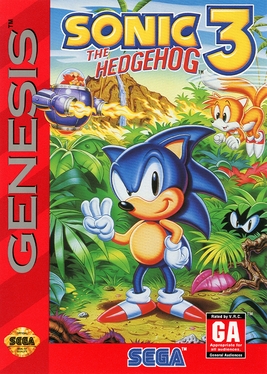
Sonic the Hedgehog 3 is a 1994 platform game developed and published by Sega for the Genesis. Like previous Sonic games, players traverse side-scrolling levels while collecting rings and defeating enemies. They control Sonic and Tails, who attempt to retrieve the Chaos Emeralds to stop Doctor Robotnik from relaunching his space station, the Death Egg, after it crash-lands on a mysterious floating island. Sonic 3 introduces Knuckles the Echidna, the island guardian, who lays traps for Sonic and Tails.
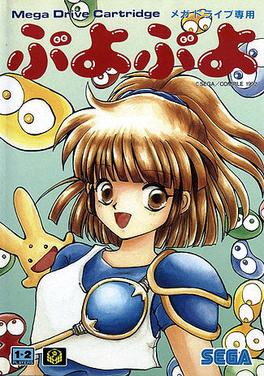
Puyo Puyo (ぷよぷよ) is a puzzle video game released in 1991 by Compile for the MSX2. Since its creation, it uses characters from Madō Monogatari. It was created by Masamitsu "Moo" Niitani, the founder of Compile, who was inspired by certain elements from the Tetris and Dr. Mario series of games.

Sonic the Hedgehog is a 1991 platform game developed by Sonic Team and published by Sega for the Genesis/Mega Drive. It was released in North America on June 23 and in PAL regions and Japan the following month. Players control Sonic the Hedgehog, who can run at near supersonic speeds; Sonic sets out on a quest to defeat Dr. Robotnik, a scientist who has imprisoned animals in robots and seeks the powerful Chaos Emeralds. The gameplay involves collecting rings as a form of health, and a simple control scheme, with jumping and attacking controlled by a single button.

Sonic the Hedgehog is a 1991 platform game. It is a companion to the 16-bit Sega Genesis game Sonic the Hedgehog for the 8-bit Master System and Game Gear consoles. Ancient—a studio founded by composer Yuzo Koshiro for the project—developed the game and Sega published it to promote the handheld Game Gear. The 8-bit Sonic is a side-scrolling game similar in style to the 16-bit game, but reduced in complexity to fit the 8-bit systems.
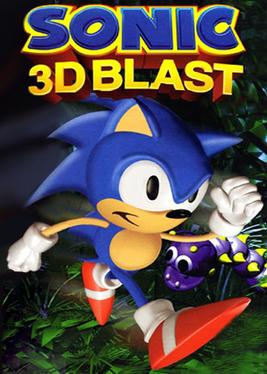
Sonic 3D Blast, known in Europe and Japan as Sonic 3D: Flickies' Island, is a 1996 platform game in the Sonic the Hedgehog series for the Sega Genesis and Sega Saturn. As Sonic the Hedgehog, the player embarks on a journey to save the Flickies, birds enslaved by Doctor Robotnik. The player must guide Sonic through a series of themed levels to collect Flickies and defeat Robotnik. Though it retains game mechanics from prior Sonic games, Sonic 3D Blast is differentiated by its 2D isometric perspective, with pre-rendered 3D models converted into sprites.

Sonic & Knuckles is a 1994 platform game developed and published by Sega. Players control Sonic the Hedgehog or Knuckles the Echidna in their quests to save Angel Island; Sonic tries to stop Doctor Robotnik from re-launching his orbital weapon, the Death Egg, while Knuckles scuffles with Robotnik's minion, EggRobo. Like previous Sonic games, players traverse side-scrolling levels at high speeds while collecting rings and defeating enemies.

Sonic Blast is a 1996 side-scrolling platform video game known for its use of pre-rendered visuals. To stop Doctor Robotnik from using Chaos Emerald shards to fortify his base, the player controls Sonic the Hedgehog and Knuckles the Echidna through 15 levels. As a Sonic the Hedgehog series platformer, the characters run and jump to reach the end of a level while defeating enemy robots and collecting rings. In separate bonus stages, the player must run forward and collect rings to earn one of the Chaos Emerald shards.

Sonic the Hedgehog Spinball, also known as Sonic Spinball, is a 1993 pinball video game developed by Sega Technical Institute and published by Sega. It is a spinoff of the Sonic the Hedgehog series. Players control Sonic the Hedgehog, who must stop Doctor Robotnik from enslaving the population in a giant pinball-like mechanism. The game is set in a series of pinball machine-like environments with Sonic acting as the pinball.

Kirby's Avalanche, known in Europe as Kirby's Ghost Trap, is a puzzle video game developed by Compile and Banpresto and published by Nintendo for the Super Nintendo Entertainment System. It was released on February 1, 1995 in Europe and on April 25, 1995 in North America. It is a Western release of the Japanese Super Puyo Puyo featuring characters from the Kirby series. There was not a Japanese release, and the game remains the only Kirby title not released there. In Europe and Australia, the game was re-released on the Wii's Virtual Console service on July 27, 2007 and in North America on September 24, 2007. The game was re-released for the Nintendo Switch Online service on July 21, 2022.

Sonic Drift is a 1994 racing game based on Sonic the Hedgehog developed and published by Sega for the Game Gear. Players control one of four characters as they race to the finish line, with 18 tracks themed after levels in 1991's Sonic the Hedgehog.
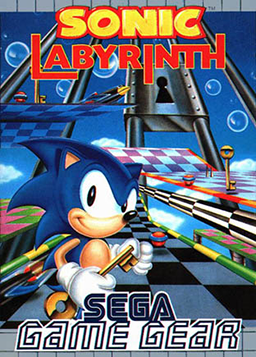
Sonic Labyrinth is an action-puzzle game developed by Minato Giken and published by Sega for the Game Gear in 1995. The game features Sonic the Hedgehog exploring maze-like stages from an isometric perspective. Dr. Robotnik has robbed Sonic of his trademark speed, so Sonic walks slowly but can roll into a ball and dash across the stages.

Sonic the Hedgehog: Triple Trouble is a 1994 platform game developed by Aspect and published by Sega for the Game Gear. It is the sequel to Sonic Chaos (1993) and features classic side-scrolling Sonic gameplay. The player controls either Sonic the Hedgehog or Miles "Tails" Prower as they venture to protect the powerful Chaos Emeralds from Doctor Robotnik, Knuckles the Echidna, and series newcomer Nack the Weasel. Sonic and Tails' unique abilities, as well as various power-ups, can assist the player in gameplay.
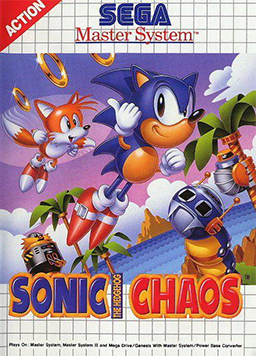
Sonic Chaos is a 1993 platform game published by Sega for the Master System and Game Gear. Players control Sonic the Hedgehog and his sidekick Miles "Tails" Prower in their quest to retrieve the Chaos Emeralds from Doctor Robotnik, who has stolen them to construct nuclear weapons. Gameplay involves running through stages, collecting rings, and defeating enemies. It is largely based on the Master System version of Sonic the Hedgehog 2, and is thus considered a follow-up to that game. Chaos is the first Sonic game for the Master System and Game Gear to feature Tails as a separate playable character with his own unique abilities.

Sonic Gems Collection is a 2005 compilation of Sega video games, primarily those in the Sonic the Hedgehog series. The emulated games span multiple genres and consoles—from the Sega Genesis to the Sega Saturn—and retain the features and errors of their initial releases with minimal edits. Player progress is rewarded with demos of other Sonic games, videos, and promotional artwork spanning the history of the Sonic franchise. While its 2002 predecessor, Sonic Mega Collection, comprises popular Sonic games, Gems Collection focuses on more obscure games, such as Sonic CD (1993) and Sonic the Fighters (1996). Other non-Sonic games are included, but some, such as the Streets of Rage trilogy, are omitted in the Western localization.

Pac-Attack, also known as Pac-Panic, is a 1993 falling-tile puzzle video game developed and published by Namco for the Super Nintendo Entertainment System and Sega Genesis. Versions for the Game Boy, Game Gear and Philips CD-i were also released. The player is tasked with clearing out blocks and ghosts without them stacking to the top of the playfield — blocks can be cleared by matching them in horizontal rows, while ghosts can be cleared by placing down a Pac-Man piece that can eat them. It is the first game in the Pac-Man series to be released exclusively for home platforms.

Sonic the Hedgehog 2 is a 1992 platform game developed by Aspect and published by Sega for the Master System and Game Gear. It is the sequel to the 8-bit Sonic the Hedgehog (1991) and follows Sonic as he attempts to get the Chaos Emeralds back to rescue his friend Miles "Tails" Prower from Dr. Robotnik. Like the first Sonic the Hedgehog, players run through levels at high speeds while collecting rings and defeating enemies. Although it shares the same title with Sonic the Hedgehog 2 for the Sega Genesis and their releases coincided, the games have little in common and share no levels.

Sonic the Hedgehog 2 is a 1992 platform game developed by Sega Technical Institute (STI) for the Sega Genesis. Players control Sonic as he attempts to stop Doctor Robotnik from stealing the Chaos Emeralds to power his space station. Like the first Sonic the Hedgehog (1991), players traverse side-scrolling levels at high speeds while collecting rings, defeating enemies, and fighting bosses. Sonic 2 introduces Sonic's sidekick Miles "Tails" Prower and features faster gameplay, larger levels, a multiplayer mode, and special stages featuring pre-rendered 3D graphics.

Puyo Puyo 2 is a 1994 puzzle video game developed and published by Compile. It's the second installment in the Puyo Puyo series and the sequel to Puyo Puyo (1992).
Puyo Puyo (ぷよぷよ), previously known as Puyo Pop outside Japan, is a series of tile-matching video games created by Compile. Sega has owned the franchise since 1998, with games after 2001 being developed by Sonic Team. Puyo Puyo was created as a spin-off franchise to Madō Monogatari, a series of first-person dungeon crawler role-playing games by Compile from which the Puyo Puyo characters originated. The series has sold over 10 million copies, including the Madō Monogatari games.



















